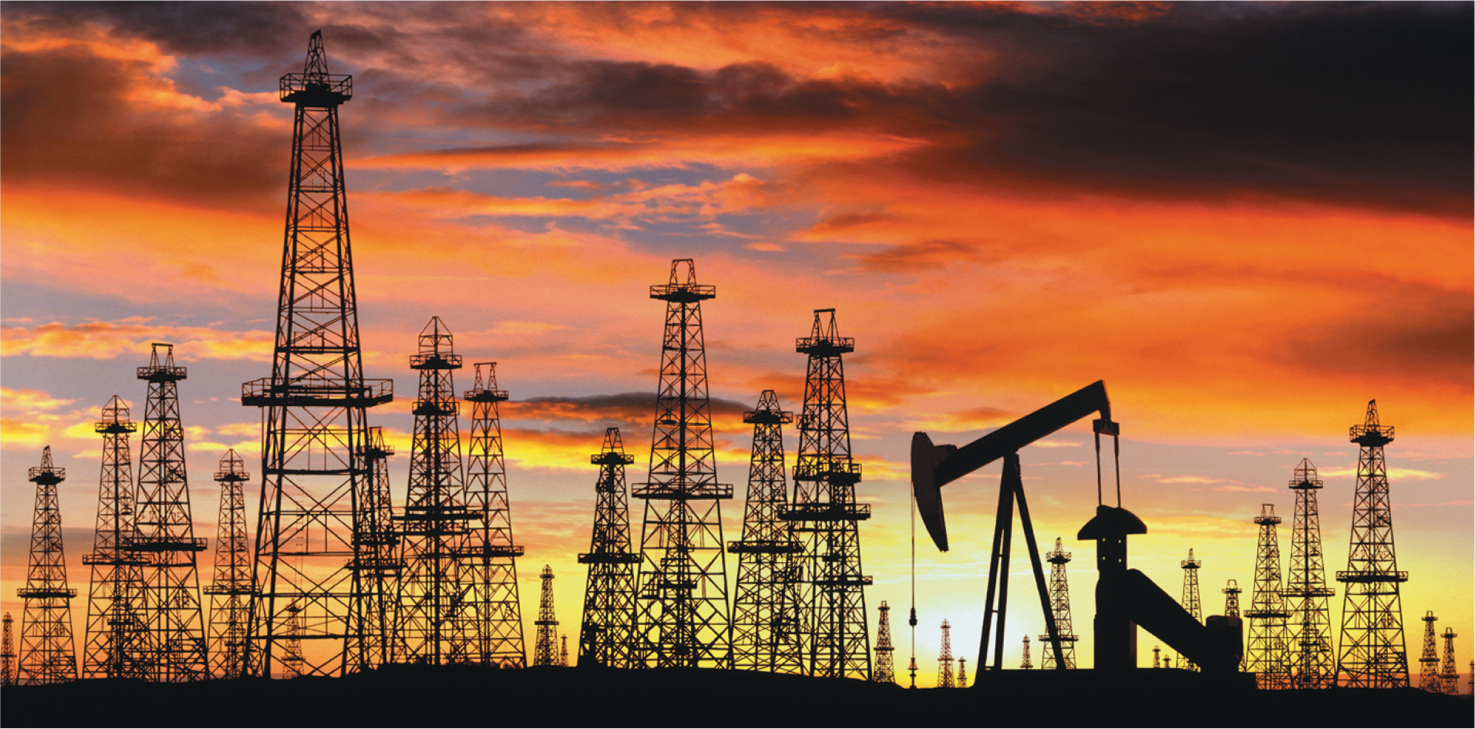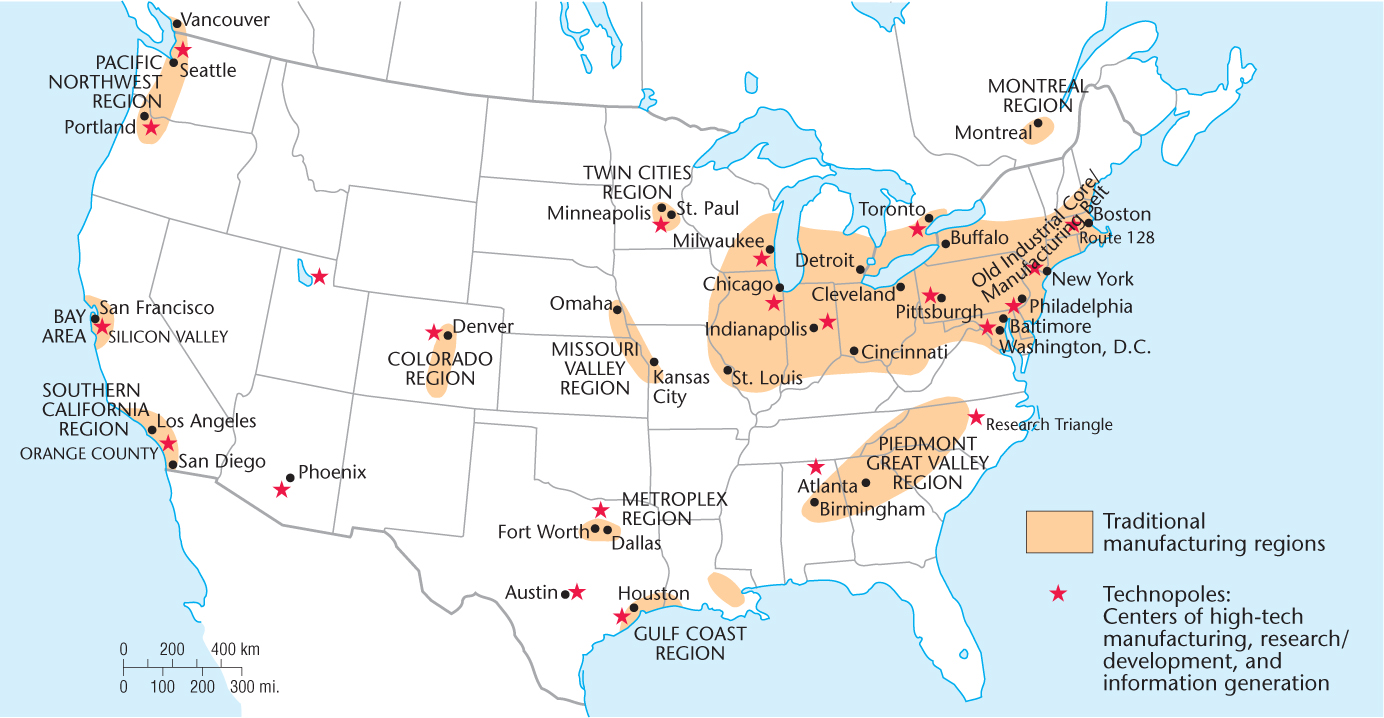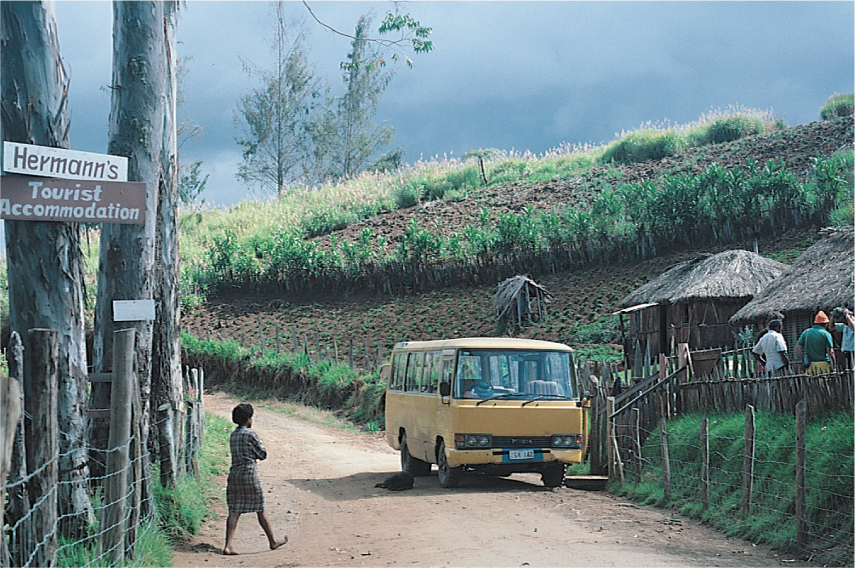Industrial and Service Regions
Industrial and Service Regions

How can the theme of culture region be applied to industrial activity? Several types of industrial regions can be identified, and each occupies a distinct culture region.
Primary and Secondary Industries
Primary and Secondary Industries
primary industry An industry engaged in the extraction of natural resources, such as fishing, farming, hunting, lumbering, and mining.
secondary industry An industry engaged in processing raw materials into finished products; manufacturing.
Primary industries refer to industries involved in extracting natural resources from Earth. Fishing, farming, hunting, lumbering, oil extraction, and mining are examples of primary industries (Figure 9.3). Although primary industries are located throughout the world, it is in the developing world that these economic activities dominate. Secondary industries process the raw materials extracted by primary industries, transforming them into more usable forms. Ore is converted into steel; logs are milled into lumber; and fish are processed and canned. Manufacturing is a more common way of referring to secondary industries. Manufacturing activities are found throughout the world, though they tend to cluster in particular areas because of favorable circumstances such as cheap power sources or available labor (Figure 9.4).

Thinking Geographically
Question 9.3
The tall derricks are an older technology, while the “grasshopper” pump to the right is newer. Why are the derricks spaced so close together? How can you tell that this field is still productive?

Thinking Geographically
Question 9.4
Why do high-tech industries have a distribution different from that of more traditional manufacturing?
Services
Services
services The range of economic activities that provide services to people and industry.
In many parts of the developed world, where people import the bulk of their manufactured products, economic activities are dominated by services, the range of economic activities that provide services to people and industry. Services include all the different types of work necessary to make goods and resources circulate and get delivered to people. So wide is the range of services that some geographers find it useful to distinguish three different types: transportation/communication services, producer services, and consumer services.
253
transportation/ communication services The range of economic activities that provide transport, communication, and utilities to businesses.
Transportation/communication services include transportation, communication, and utility (such as power companies) services. Highways, railroads, waterways, airlines, pipelines, telephones, radio, television, and the Internet are all transportation/communication services. All facilitate the distribution of goods, services, and information. Modern industries require well-developed transport systems, and every industrial district is served by a network of such facilities.
Major regional differences exist in the relative importance of the various modes of transport. In Russia and Ukraine, for example, highways are not very important to industrial development; instead, railroads—and to a lesser extent waterways—carry much of the transport load. Indeed, Russia still lacks a paved transcontinental highway. In the United States, by contrast, highways reign supreme, while the railroad system has declined. Western European nations rely heavily on a greater balance among rail, highway, and waterway transport. Meanwhile, electronic transfers of funds and telecommunications between computers continents apart add a new dimension and speed to the exchange of data and ideas.
producer services The range of economic activities required by producers of goods, including insurance, legal services, banking, advertising, wholesaling, retailing, information generation, and real-estate transactions.
Producer services are services required by the manufacturers of goods, including insurance, legal services, banking, advertising, wholesaling, retailing, consulting, information generation, and real estate transactions. Such businesses represent one of the major growth sectors in developed economies, and a geographical segregation has developed in which manufacturing is increasingly shunted to the peripheries while corporate headquarters and the producer-related service activities remain, for the most part, in the core. Some of these producer service activities, however, are now moving offshore, to such places as the Caribbean and India, to take advantage of educated but low-wage workers. Nevertheless, the main control centers for these large companies are still located within the major cities of the West.
high-tech corridor An area along a limited-access highway that houses offices and other services associated with high-tech industries.
Increasingly important in the producer service industries are the collection, generation, storage, retrieval, and processing of computerized information, including research, publishing, consulting, and forecasting. The impact of computers has changed and is continuing to change the world dramatically. Many producer service businesses depend on a highly skilled, intelligent, creative, and imaginative labor force. Although information-generating activity in the United States is focused geographically in the old industrial core, the distribution of this activity, if viewed on a more local scale, can be seen to coalesce around major universities and research centers. The presence of Stanford University and the University of California at Berkeley, for example, helped make the San Francisco Bay Area a major center of such industry. Similar technological centers have developed near Harvard and MIT in New England and near the Raleigh–Durham–Chapel Hill Research Triangle of North Carolina (see Figure 9.4). These high-tech corridors—or “silicon landscapes,” as some have dubbed them—occupy relatively little area. They tend to be located in offices along a limited-access highway. In other words, the information economy is highly focused geographically, contributing to and heightening uneven development spatially. In Europe, for example, the emerging core of producer service industries is even more confined geographically than the earlier concentration of manufacturing.
254
consumer services The range of services provided to the general public, including education, government, recreation and tourism, and health care.
Consumer services are those provided to the general public, and they include education, government, recreation and tourism, and health care. Many of these activities are also shifting their locations, since the Internet has made it possible to provide these services remotely. For example, some American executives find themselves so busy at work and with their families that they have hired personal assistants to schedule their travel, medical appointments, and so on. Some of these services are now located in India. Similarly, some educational activities can now be done through the Internet. A company called Tutor Vista employs 600 tutors in India to help American students with their homework. The company has over 10,000 subscribers.
One of the most rapidly expanding activities included under consumer services is tourism. As early as 1990, this industry accounted for 5.5 percent of the world’s economy, generated $2.5 trillion in income, and employed 112 million workers—more than any other single industrial activity, and amounting to 1 of every 15 workers in the world. Just a decade later, the total income generated had risen to $4.5 trillion, and tourism employed 1 of every 12 workers. This trend toward the increased importance of tourism has continued and spread through most regions of the world, often in spite of terrorist attacks directed against tourists, as in Bali in 2002 and Mumbai in 2008. By 2012, it was estimated that 235 million people work in the tourism industry, though tourism has suffered in recent years as a result of a prolonged world recession.
255
Like all other forms of industry, tourism varies greatly in importance from one region or country to another (Figure 9.5), with some countries, particularly those in tropical island locations, depending principally on tourism to support their national economies (Figure 9.6).

Thinking Geographically
Question 9.5
What bias might be built into such a map?

Thinking Geographically
Question 9.6
How might these places change as a result of tourism?
In general, countries that are dominated by primary industries tend to be in the developing category, while countries that are dominated by services are considered to be in the developed category. But, of course, the world and its economies are complex, and there are many exceptions to the general association of different types of economic activities and stages of economic development as outlined earlier. Countries in the Persian Gulf region, like Saudi Arabia, are considered fairly developed, yet their economies are dominated by a primary industry, oil extraction. In contrast, countries like the Russian Federation that were industrialized long ago often are placed in the category of developing regions. So stages of economic activity don’t necessarily explain why some countries are rich and some countries are poor; other factors must be considered too, like political stability and cultural values. Rich and poor are not always indicators of social development, because money does not always correlate to a higher standard of living.
256
Understanding why some regions of the world are richer than other regions, and why some groups of people have better access to such things as education and health care, is a difficult affair. We can see that the answers to these questions are related to a region’s economic structure—whether its economy is dominated by primary industry, secondary industry, or services—but we know that the economy is not the only factor to consider. In the next section, we take a closer look at the changing geography of industrialization itself, beginning with where it began and how it diffused.